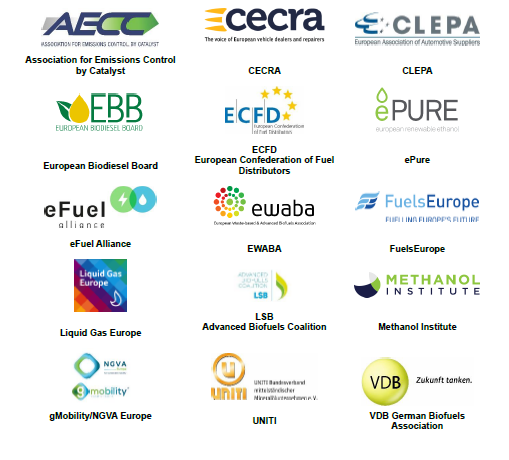Joint industry statement questions accuracy of ICCT briefing on assessing alleged risks of crediting alternative fuels in Europe's CO2 standards for trucks and buses
Representing the collaborative voice of the transport, fuel manufacturing, engineering, and energy sectors, we would like to respond to the recently published briefing by the International Council on Clean Transportation (ICCT) on the assessment of alleged risks associated with crediting alternative fuels in Europe's CO2 standards for trucks and buses.
Exclusive focus on Tank-to-Wheel emission calculation is misleading – and incorrect
ICCT's consideration of Tank-to-Wheel (TtW) emission savings only, particularly the assumption that electric trucks would consistently utilize 100% renewable electricity with zero CO2 emissions, is not correct and misleading. This oversimplification fails to account for the complexities of the entire lifecycle, including the carbon footprint associated with battery production.
The introduction of a Carbon Correction Factor (CCF) would complement the uptake of zero-emission trucks by overhauling the regulation's outdated focus on tailpipe emissions assessment and providing more flexibility and choice by reflecting the greenhouse gas savings (GHG) from renewable fuels. Moreover, a lifecycle perspective – as demonstrated by the LCA Interactive model for HDVs, developed by IFP Energies Nouvelles and commissioned by Concawe – provides a more accurate representation of actual carbon footprints.
It is false that all truck manufacturers oppose the CCF. Notably, some of them have already expressed support, while numerous suppliers, representing a significant portion of the value chain, welcome the CCF too. Over 120 companies, associations, and 90 scientists endorse this approach.
Other incorrect elements in the ICCT briefing
- GHG savings of biodiesel: The graphs and information on the GHG savings of biodiesel are incorrect. Due to their uncertainty, the RED GHG methodology does not include potential ILUC emissions (these are only in the RED for reporting). In fact, the use of biodiesel in 2021 delivered between 77% and 81% GHG emissions savings, using the RED official fossil fuel comparator. As a result, about 45 MtonneCO2eq emissions were saved, see here. Moreover, concerns with deforestation and other risks are already addressed in EU legislation by foreseeing the phase-out of high ILUC risk biofuels by 2030. Therefore, allegations referring to palm oil and calculations based on these indirect emissions are not justified, but intentionally misleading.
- Definition of carbon neutral fuels: to ensure coherence claims, all proposed definitions of carbon-neutral fuels adhere to RED requirements including caps and sustainability criteria. Allegations that these fuels could incentivize risky usage beyond existing safeguards are therefore unfounded.
- Type approval system: The insistence on a 100% CO2 reduction, including all upstream emissions, is impractical and renders the approach ineffective (i.e. killing any meaningful role for low-carbon liquid fuels). No existing fuels meet such requirements. Furthermore, the same 100% CO2 reduction criteria should be equally to all other technologies, including upstream of e-trucks, i.e.battery production, and charging electricity.
- Fuel crediting system: The fuel crediting system is designed to include only additional amounts of carbon-neutral fuels, maintaining RED caps and sustainability criteria. Allegations about the system leading to additional crop-based biofuels are baseless.
- Problem with double incentives: ICCT claims that renewable fuels are already incentivised by other legislation such as RED, so there would be no need (or would even be counter-productive) to incentivise them through other legislation such as CO2 emission standards. This is wrong, as both legislations set completely different targets, for different obliged parties, and high RED mandates would not mean that these fuels would be able to be used for road transport, i.e. if renewable fuels are not considered in the relevant regulations on CO2 emission standards for new vehicles.
- Additional consideration on CCF: The current legislation ignores the fact that the actual fuel mix does not consist of 100% fossil fuels, but instead contains a steadily increasing share of renewable fuels, as required by the RED. The CCF would simply address this shortcoming and correct the tailpipe emissions value of a heavy-duty vehicle (as calculated for compliance assessment purposes) by the corresponding GHG savings.
In addition, the largest consumption of renewable diesel and gas in the transport sector will be in heavy-duty vehicles. For that reason, the EU Environment Agency's SHARES database, which records the amounts of renewable energy in all Member States – including all types of renewable fuels that suppliers are required to put on the market to meet their RED obligations – is the best available, and suitable data source, and can be technically improved if more detailed data is required.
We welcome constructive dialogue, and remain committed to finding sustainable solutions that align with the goals of reducing CO2 emissions in the transportation sector. Achieving ambitious climate targets demands the integration of all available solutions, with renewable, low-carbon fuels playing an essential role in the effective decarbonisation of the transport sector.
In conclusion, the co-signing organizations believe that a comprehensive approach that looks at the entire lifecycle of vehicles is essential.



